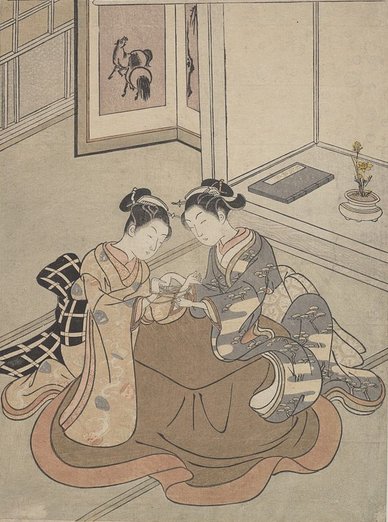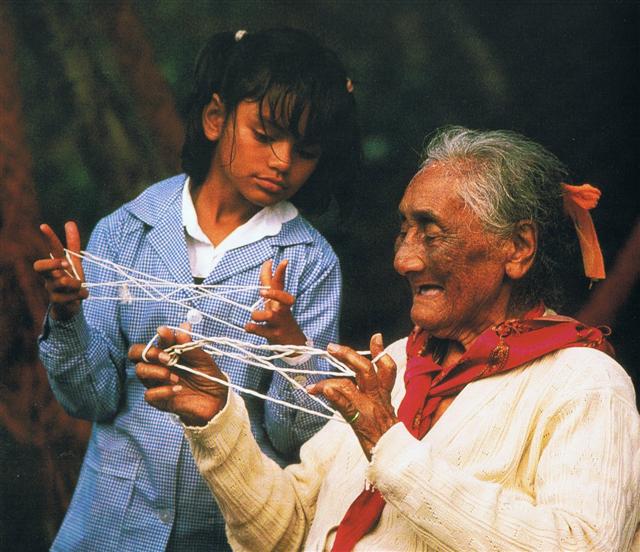Gregory XIII had to draw back Manus Catenata because in the Julian calendar the stars had drifted too far ahead in the year: ... The Julian calendar day Thursday, 4 October 1582 was followed by the first day of the Gregorian calendar, Friday, 15 October 1582 (the cycle of weekdays was not affected) ... In rongorongo times Manus Catenata was at March 14 (3-14, 73 = 365 / 5) which was 365 + 73 - 80 = 358 days after 0h and 4 days later in the year than at the time of Gregory XIII, when Manus Catenata had been at day 73 - 4 = 69 (ºMarch 10) = 12 * 29½ = 354 days after 0h. The time was ripe for a calendar reform because in the Julian calendar Manus Catenata had reached day 354 + 11 = 365 after 0h.
In the picture above the name Ketos (the Sea Beast, Cetus) was written from left to right in normal Sun fashion whereas the names of star persons (Perseus and Andromeda) were written withershins. The precession moved the Sun in one direction and the stars in the opposite direction. ... string games could be resumed after it was clear that the Sun had managed to leave the horizon and was rapidly gaining in altitude: 'Before the sun starts to leave the horizon ... when it shows only on the horizon, ... then string games were no longer allowed as they might lacerate the sun. Once the sun had started to go higher and could be seen in its entirety, string games could be resumed, if one so wished. So the restriction on playing string games was only applicable during the period between the sun's return and its rising fully above the horizon ...
... I knew of two men who lived in another settlement on the Noatak river. They did not believe in the spirit of the string figures, but said they originated from two stars, agguk, which are visible only when the sun has returned after the winter night. One of these men was inside a dance-house when a flood of mist poured in ... His two companions rapidly made and unmade the figure 'Two Labrets', an action intended to drive away the spirit of the string figures, uttering the usual formula ... but the mist kept pouring in ... ... Again, in a diary entry dated 18 December 1913 Jenness notes the same Alak telling him that 'they never played cat's cradles while two stars called agruk were visible, just before the long days of summer... They played other games then, like whizzer [a noise maker] ... ... Alak's comments indicate that, for the Noatak area at least, the appearance of Aagjuuk, rather than the Sun, signalled the end of the string-game season. And the opinion ... that string figures came from, and are therefore related to, Aagjuuk may have given rise to the prohibition against playing them after the solstice appearance of these stars. It is also possible that the string game mentioned by Alak - 'Two Labrets' - rapidly made and unmade in an attempt to drive off the 'string figure spirit', was intended to symbolize Aagjuuk's two stars and so confound the constellation with its own likeness or spirit. ... Etalook refers to the 'aagruuk' as 'labrets' (the circular lower-lip ornaments of some Western Arctic Eskimo groups, certainly evoke an astral image if we recall that early Inuit graphic representations of stars were usually circular ...) giving them, it seems, an alternate name, ayaqhaagnailak, 'they prohibit the playing of string games': They are the ones that discourage playing a string game... That's what they're called, ayaqhaagnailak, those two stars... When the two stars come out where is no daylight, people are advised not to play a string game then, but with hii, hii, hii... toy noisemakers of wood or bone and braided sinew ... ... The kaikai are the rythmic songs that are sung to cat's cradles, the string games that are found not only throughout the Pacific but throughout the world. On premissionary Rapa Nui the kaikai, together with their corresponding cat's cradles, were not simple children's games but were used, among other things, to produce magic effect. They were highly important for the study of Rapa Nui's rongorongo. This is because it was apparently with the aid of cat's cradles that the rongorongo experts taught their pupils to learn many of the chants accompanying the incised inscriptions ...
... The late Amelia Tepano Ika was a beloved link with the past, a much sought-after teacher of the art of kaikai, string figures made and presented with accompanying chants ... |
||||||||||||||||||||||||||||||||||||||||||||||||||||||||||||||






